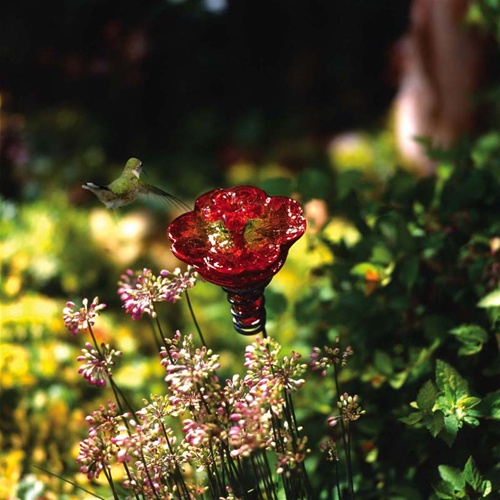There are three varieties of Hummingbirds that frequent our area in Virginia, the Rufous, Allen’s and the Ruby Throated hummingbird. Our favorite is the last but not least in that list, for its brilliant hues and and signature ruby-red colored throat.
Highly curious and very attracted to feeders, the Ruby Throat is one of the most common and recognizable hummingbirds in the eastern half of North America. Living up to their name, males have vibrant green feathers, white stomachs and a red “ruby” throat, while females are larger and resemble males in coloring, but lack that namesake red throat. Hummingbirds often become so adapted to people that they may even dive closer to explore your red wardrobe, and seem indifferent to being watched closely while feeding near windows or patios. Hanging a hummingbird feeder near a large window is one of the most relaxing ways to pass time, as many males become territorial over their feeder and spend a lot of time chasing others away. (If hanging a feeder is difficult, we also have a great Staked Hummingbird Feeder that includes a stake for easy placement.) These fast, feathered air battles are more dramatic than your favorite soap opera and more entertaining than most sporting events! It’s best to place multiple hummingbird feeders throughout your yard, out of sight of each other, so that territorial lines aren’t crossed as often and everyone gets a chance to feed. Placing your feeders in the shade will also help give these hardworking hummers a respite from the hot summer sun!
Most of these hummers migrate to the deep south and Caribbean to wait out the cold winters, but tend to show back up with the blooming of spring flowers in late April and early June, here on the east coast. Beautiful and entertaining, these quick, little birds are terrific pollinators in your garden and drink half to eight times their body weight in nectar, and frequently dine on small, soft insects. During the sweltering summer months, make sure to change the sugary “nectar” in each of your feeders once a week, regardless of whether the birds have been feeding or not. This keeps the sugar-water fresh, as it will actually spoil in the summer heat. Though they love red, tubular shaped flowers, they will visit other sweetly-scented blossoms and blooming aromatic herbs as well. Try planting Asclepias ‘Tuberosa’, Bergamot and Lobelia to create a hummingbird habitat in your garden. Doing so will increase the health of your garden and give you a great, natural hive of activity to study!


What will prevent ants and wasps from dominating this kind of feeder and spoiling the nectar?
Great question Mike! There are a few options to thwart ants and wasps from overwhelming your staked feeders. You can spray the stake and surrounding ground with White or Apple Cider Vinegar, or sprinkle cinnamon around the base of the feeder to keep ants away. Placing your feeder among herbs that act as natural insect repellents like Mint, Rue, Rosemary or Basil, can also help.
Most feeders are designer to have feeding holes that only hummingbirds can access, as bees and wasps don’t have long enough proboscises to reach the nectar level inside. A hummingbird’s long tongue can reach through the narrow opening easily, to access the sugary mix inside. Also, because most hummers are pretty territorial about their feeders, in most cases they will chase the wasp or bee away. Another idea is to move your feeders regularly around your yard or garden. The hummingbirds are smart enough to find them, but it takes the insects a little longer to catch on.